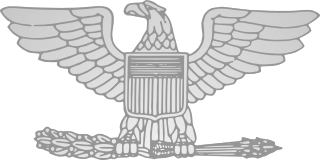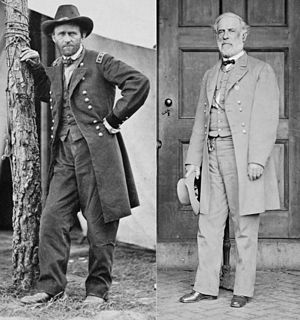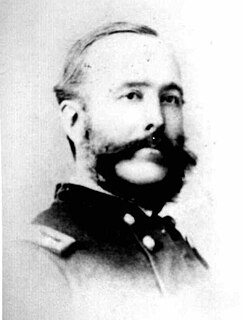
William Gamble was a civil engineer and a United States Army cavalry officer. He served during the Second Seminole War, and fought for the Union during the American Civil War. He commanded one of two brigades in Brigadier General John Buford's Division of Cavalry, in which he played an important role in defending Union positions during the first day of the Battle of Gettysburg.

Wesley Merritt was an American major general who served in the cavalry of the United States Army during the American Civil War, American Indian Wars, Spanish–American War, and the Philippine–American War. Following the latter war, he became the first American Military Governor of the Philippines.
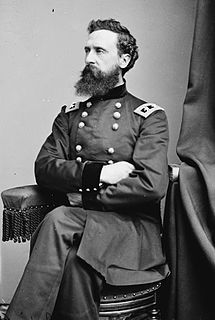
George Sykes was a career United States Army officer and a Union General during the American Civil War.

David McMurtrie Gregg was a farmer, diplomat, and a Union cavalry general in the American Civil War.

Fitzhugh Lee was a Confederate cavalry general in the American Civil War, the 40th Governor of Virginia, diplomat, and United States Army general in the Spanish–American War. He was the son of Sydney Smith Lee, a captain in the Confederate States Navy, and the nephew of General Robert E. Lee.

The VI Corps was a corps of the Union Army during the American Civil War.
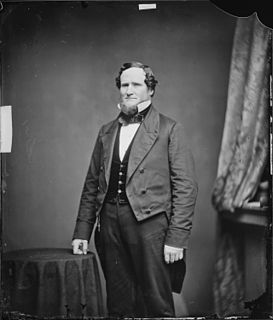
William Barksdale was a lawyer, newspaper editor, U.S. Congressman, slaveholder and a Confederate general in the American Civil War. A staunch secessionist, he was mortally wounded during the Battle of Gettysburg while leading his brigade's attack on Union forces not far from Cemetery Ridge.

Romeyn Beck Ayres was a Union Army general in the American Civil War.
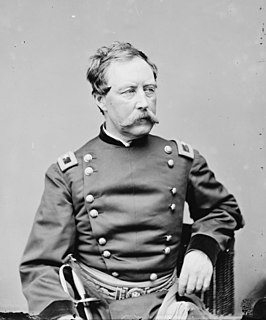
Albion Parris Howe was a Union Army general in the American Civil War. Howe's contentious relationships with superior officers in the Army of the Potomac eventually led to his being deprived of division command.

Cadmus Marcellus Wilcox was a career United States Army officer who served in the Mexican–American War and also was a Confederate general during the American Civil War.

John Rutter Brooke was one of the last surviving Union generals of the American Civil War when he died at the age of 88.

Thomas Algeo Rowley was a Union Army general in the American Civil War. Following charges about the conduct of his officers at Gettysburg, Rowley was tried by a court martial that was later declared biased, and he was reinstated.
Adolphus (Adolph) Buschbeck commanded the 27th Pennsylvania Infantry in the Army of the Potomac and a brigade in that army and later in the Army of the Cumberland during the American Civil War.

George Ashworth Cobham Jr. commanded a regiment in the American Civil War and rose to brigade command before being killed in battle.
Archibald Livingston McDougall was an officer in the Union Army during the American Civil War who commanded the 123rd New York Volunteer Infantry early in the war and subsequently led a brigade at the Battle of Gettysburg.

John Baillie McIntosh, although born in Florida, served as a Union Army brigadier general in the American Civil War. His brother, James M. McIntosh, served as a Confederate general until he was killed in the Battle of Pea Ridge.
Chapman Biddle was a member of the prominent Biddle family of Philadelphia, Pennsylvania, who served as an officer in the Union Army in the American Civil War. He commanded a brigade of infantry at the Battle of Gettysburg.

Daniel Davidson Bidwell was a civic leader in Buffalo, New York, before the outbreak of the American Civil War. He enlisted early in the war and then was appointed colonel of a regiment of infantry. He was promoted to general in command of a brigade in early 1864, leading it until he was mortally wounded at the Battle of Cedar Creek.
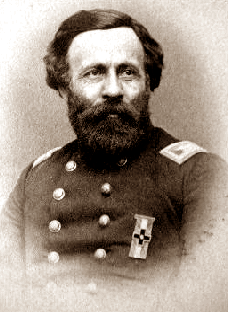
Hiram Burnham was an officer in the Union Army who commanded a regiment and then a brigade in the Eastern Theater of the American Civil War. He was killed in battle while assaulting Confederate positions near Richmond, Virginia, during the Battle of Chaffin's Farm.







